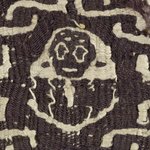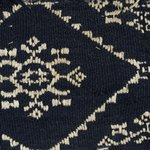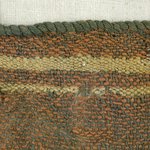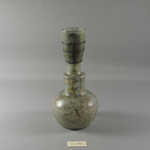

Coptic. Funerary Stela with Boy Standing in a Niche, 4th–5th century C.E. Limestone, ancient and modern paint in ochre, dark terracotta, brown, black and flesh-tone, 27 9/16 x 9 5/8 x 6 1/2 in. (70 x 24.5 x 16.5 cm). Brooklyn Museum, Charles Edwin Wilbour Fund, 58.129. Creative Commons-BY (Photo: Brooklyn Museum, 58.129_PS2.jpg)

Coptic. Funerary Stela with Boy Standing in a Niche, 4th–5th century C.E. Limestone, ancient and modern paint in ochre, dark terracotta, brown, black and flesh-tone, 27 9/16 x 9 5/8 x 6 1/2 in. (70 x 24.5 x 16.5 cm). Brooklyn Museum, Charles Edwin Wilbour Fund, 58.129. Creative Commons-BY (Photo: Brooklyn Museum, 58.129.jpg)

Coptic. Funerary Stela with Boy Standing in a Niche, 4th–5th century C.E. Limestone, ancient and modern paint in ochre, dark terracotta, brown, black and flesh-tone, 27 9/16 x 9 5/8 x 6 1/2 in. (70 x 24.5 x 16.5 cm). Brooklyn Museum, Charles Edwin Wilbour Fund, 58.129. Creative Commons-BY (Photo: Brooklyn Museum, 58.129_bw.jpg)

Coptic. Funerary Stela with Boy Standing in a Niche, 4th–5th century C.E. Limestone, ancient and modern paint in ochre, dark terracotta, brown, black and flesh-tone, 27 9/16 x 9 5/8 x 6 1/2 in. (70 x 24.5 x 16.5 cm). Brooklyn Museum, Charles Edwin Wilbour Fund, 58.129. Creative Commons-BY (Photo: Brooklyn Museum, 58.129_detail1.jpg)

Coptic. Funerary Stela with Boy Standing in a Niche, 4th–5th century C.E. Limestone, ancient and modern paint in ochre, dark terracotta, brown, black and flesh-tone, 27 9/16 x 9 5/8 x 6 1/2 in. (70 x 24.5 x 16.5 cm). Brooklyn Museum, Charles Edwin Wilbour Fund, 58.129. Creative Commons-BY (Photo: Brooklyn Museum, 58.129_detail2.jpg)

Coptic. Funerary Stela with Boy Standing in a Niche, 4th–5th century C.E. Limestone, ancient and modern paint in ochre, dark terracotta, brown, black and flesh-tone, 27 9/16 x 9 5/8 x 6 1/2 in. (70 x 24.5 x 16.5 cm). Brooklyn Museum, Charles Edwin Wilbour Fund, 58.129. Creative Commons-BY (Photo: Brooklyn Museum (in collaboration with Index of Christian Art, Princeton University), CUR.58.129_detail01_ICA.jpg)

Coptic. Funerary Stela with Boy Standing in a Niche, 4th–5th century C.E. Limestone, ancient and modern paint in ochre, dark terracotta, brown, black and flesh-tone, 27 9/16 x 9 5/8 x 6 1/2 in. (70 x 24.5 x 16.5 cm). Brooklyn Museum, Charles Edwin Wilbour Fund, 58.129. Creative Commons-BY (Photo: Brooklyn Museum (in collaboration with Index of Christian Art, Princeton University), CUR.58.129_detail02_ICA.jpg)

Coptic. Funerary Stela with Boy Standing in a Niche, 4th–5th century C.E. Limestone, ancient and modern paint in ochre, dark terracotta, brown, black and flesh-tone, 27 9/16 x 9 5/8 x 6 1/2 in. (70 x 24.5 x 16.5 cm). Brooklyn Museum, Charles Edwin Wilbour Fund, 58.129. Creative Commons-BY (Photo: Brooklyn Museum (in collaboration with Index of Christian Art, Princeton University), CUR.58.129_detail03_ICA.jpg)

Coptic. Funerary Stela with Boy Standing in a Niche, 4th–5th century C.E. Limestone, ancient and modern paint in ochre, dark terracotta, brown, black and flesh-tone, 27 9/16 x 9 5/8 x 6 1/2 in. (70 x 24.5 x 16.5 cm). Brooklyn Museum, Charles Edwin Wilbour Fund, 58.129. Creative Commons-BY (Photo: Brooklyn Museum (in collaboration with Index of Christian Art, Princeton University), CUR.58.129_detail04_ICA.jpg)

Coptic. Funerary Stela with Boy Standing in a Niche, 4th–5th century C.E. Limestone, ancient and modern paint in ochre, dark terracotta, brown, black and flesh-tone, 27 9/16 x 9 5/8 x 6 1/2 in. (70 x 24.5 x 16.5 cm). Brooklyn Museum, Charles Edwin Wilbour Fund, 58.129. Creative Commons-BY (Photo: Brooklyn Museum (in collaboration with Index of Christian Art, Princeton University), CUR.58.129_detail05_ICA.jpg)

Coptic. Funerary Stela with Boy Standing in a Niche, 4th–5th century C.E. Limestone, ancient and modern paint in ochre, dark terracotta, brown, black and flesh-tone, 27 9/16 x 9 5/8 x 6 1/2 in. (70 x 24.5 x 16.5 cm). Brooklyn Museum, Charles Edwin Wilbour Fund, 58.129. Creative Commons-BY (Photo: Brooklyn Museum (in collaboration with Index of Christian Art, Princeton University), CUR.58.129_detail06_ICA.jpg)

Coptic. Funerary Stela with Boy Standing in a Niche, 4th–5th century C.E. Limestone, ancient and modern paint in ochre, dark terracotta, brown, black and flesh-tone, 27 9/16 x 9 5/8 x 6 1/2 in. (70 x 24.5 x 16.5 cm). Brooklyn Museum, Charles Edwin Wilbour Fund, 58.129. Creative Commons-BY (Photo: Brooklyn Museum (in collaboration with Index of Christian Art, Princeton University), CUR.58.129_detail07_ICA.jpg)

Coptic. Funerary Stela with Boy Standing in a Niche, 4th–5th century C.E. Limestone, ancient and modern paint in ochre, dark terracotta, brown, black and flesh-tone, 27 9/16 x 9 5/8 x 6 1/2 in. (70 x 24.5 x 16.5 cm). Brooklyn Museum, Charles Edwin Wilbour Fund, 58.129. Creative Commons-BY (Photo: Brooklyn Museum (in collaboration with Index of Christian Art, Princeton University), CUR.58.129_detail08_ICA.jpg)

Coptic. Funerary Stela with Boy Standing in a Niche, 4th–5th century C.E. Limestone, ancient and modern paint in ochre, dark terracotta, brown, black and flesh-tone, 27 9/16 x 9 5/8 x 6 1/2 in. (70 x 24.5 x 16.5 cm). Brooklyn Museum, Charles Edwin Wilbour Fund, 58.129. Creative Commons-BY (Photo: Brooklyn Museum (in collaboration with Index of Christian Art, Princeton University), CUR.58.129_ICA.jpg)

Coptic. Funerary Stela with Boy Standing in a Niche, 4th–5th century C.E. Limestone, ancient and modern paint in ochre, dark terracotta, brown, black and flesh-tone, 27 9/16 x 9 5/8 x 6 1/2 in. (70 x 24.5 x 16.5 cm). Brooklyn Museum, Charles Edwin Wilbour Fund, 58.129. Creative Commons-BY (Photo: Brooklyn Museum, CUR.58.129_unearthing_coptic.jpg)
Funerary Stela with Boy Standing in a Niche
Egyptian, Classical, Ancient Near Eastern Art











































